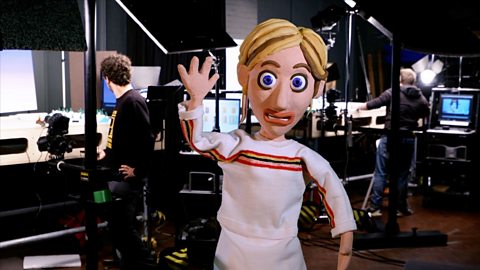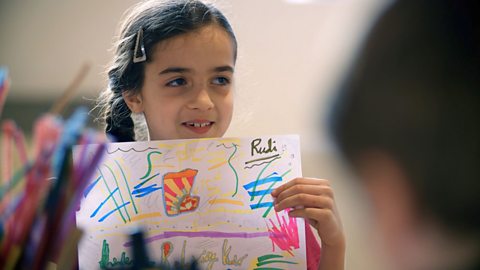Naomi: What do you think? Does it suit me?
Naomi: When you think about it, in every television programme, film or play that you see, a character’s costume tell you a whole lot about what sort of person they are.
Naomi: What a character wears can signal whether that person is rich or poor, what sort of job they do, it can even reveal aspects of their personality, like whether they are happy or sad, good or evil!
Naomi: I’m not sure that I like what this costume is saying about me. I think I'm going to go and try something different!
Naomi: Look, I just can’t seem to decide what works for me.
Naomi: I'm trying to find something that says… Sophisticated, intelligent, elegant… I just can't seem to nail it.
Naomi: I know who will know what to do… The Master.
Naomi: Scott Langridge is a costume designer who has worked on loads of television programmes, including The Worst Witch and Swashbuckle.
Scott: There are so many things you need to think about when designing a costume, from the silhouette to the design to what fabric you're going to choose.
Scott: So normally what I do is collect pictures and inspirations and fabric samples and put them onto a mood board, just like this one I designed for The Worst Witch.
Scott: When we’re designing a costume we need to put it down on paper to show everybody what we're thinking.
Scott: So here's a few tips and techniques on how to show fabric and movement in your design.
Scott: First, using a smaller brush, we're going to try and emulate these feathers with a bit of a watercolour brush, and we're going to just flick the brush up.
Scott: This will emulate the look of feathers around the collar.
Scott: The next technique we're going to show you is this solid fabric here. We can just fill the whole piece of the fabric like this.
Scott: Bleed the paint into the design.
Scott: And the last technique we're going to show you is this floaty fabric here which will show nice movement in a skirt.
Scott: So what we can do is fill the fabric in like this…
Scott: And then in the folds, make it darker so it looks like it's going behind, just like that!
Scott: Your challenge is to design a costume for a character from a book, and don't forget to use your master skills.
Scott: I think you should lose the hat, Naomi!
Naomi: Oh, OK… thanks Scott! So who is going to take on this challenge?
Naomi: First up its Jai, who has lightening fast gaming fingers!
Naomi: Next its Jasper and he's a building blocks wizard!
Naomi: And finally we've got Leilani and her magic drawing skills!
Naomi: OK so we’re going to design a costume for a character from a book. Have you got any ideas of who you're going to make a costume for?
Jasper: I'm going to do Willy Wonka from Charlie and the Chocolate Factory.
Naomi: Good choice, what about you Jai?
Jai: I'm going to do Dodger from Oliver Twist, and he's going to have a multicoloured coat.
Naomi: Nice, Leilani have you got any ideas?.
Leilani: I'm going to do Silky from The Enchanted Wood, and instead of being a nice witch she's going to be a mischief maker!
Naomi: A mischievous fairy, I like it!
Naomi: And if you’re going to have a go at this challenge, here’s what you’ll need…
Naomi: Some glue, scissors and magazines,
Naomi: a selection of fabric swatches,
Naomi: paint, paint brushes, a pencil and paper.
Naomi: OK, are we all raring to go?
Children: Oh, yeah!
Naomi: Let's do this then!
Naomi: Start by putting together a moodboard by sticking the fabrics that you think best suit your character onto some card.
Naomi: Remember to think about what your character needs to do in their costume. If they are very active the costume needs to be easy to move in.
Naomi: So choose fabrics that stretch and move.
Naomi: When you’re happy with your mood board you can draw out a figure and design how your costume should look.
Naomi: Good work guys, these look brilliant! Pleased?
Children: YEAH!
Naomi: Shall we go and try on some costumes?
Children: YEAH!
Naomi: Let's do it, come on!
Naomi: If you enjoyed this challenge there are loads more over on the BBC Teach website.
Naomi: You can write song lyrics, create a cake sculpture or even tell a story for Newsround.
Naomi: So go on, get creative!
Video summary
Presenter Naomi Wilkinson is in a costume warehouse trying on lots of different costumes.
A costume designer is an essential part of the production team of any show, they help bring to life the stylistic intentions of the director.
Costume designers use different techniques to generate their initial ideas, they might sketch, paint or use mood boards to convey to the actors and director their vision for the costumes.
Costume designers have to create design ideas that fit in with all sorts of themes and concepts, such as period dramas or large stage shows like The Lion King, and a costume can tell us a lot about a character.
We meet Scott Langridge, who is a master costume designer on many popular children’s programmes.
He demonstrates how he creates and records his costume ideas after he has received his brief.
Scott shows how he collates visual resources such as swatches of fabric and images to create a mood board.
Then he shows us how to use brush skills in a painting that conveys the texture of the different fabrics that he will include in his final costume design.
Naomi is joined by a group of children who get to work designing a costume for a character from a book.
We see their end products before they head off to try on some costumes.
This short film is from the BBC series, Get Creative.
Teacher Notes
Before Watching
Ask your pupils to recount times when they have seen impressive costumes in a performance, on television, at the cinema or on stage.
Ask them to discuss why the costume is an important element of a show and whether they have experience of being in a costume.
Ask the children to consider how they think costumes are developed (i.e. are they pre-bought or made? By who?).
After Watching
Ask pupils to select the book character they will design their costume for.
Have the children spend time creating a mood board on A3 (or larger) paper or card, they may need some visual resources to help, ones which have visual prompts linked to their stories.
You could use old magazines, newspapers or catalogues or maybe use images from the internet.
When the children have finished the mood boards they can draw a pencil outline of their character and then begin to create the painting of their final costume design.
You may want them to focus on the costume for one or two characters, and they could paint the costumes from a few angles.
Master Skill
Creating a mood board.
Using watercolour paint skills to paint a costume design.
Thinking Questions
- Have you ever had to wear a costume? How did it make you feel?
- Why are costumes an important part of any film, television or theatre production?
- How do you think costume designers collect ideas for their designs?
- Can you describe key features of the costumes? How does this link to your brief?
Supported Learning and SEN
Working with swathes of material that can be examined through touch would be a very appealing project for many SEN children.Depending on the ability of your children and the time available you may decide to split the mood board and costume design activities into two sections or simply to have the creation of the mood board as your final outcome – this activity is very accessible even to those who have difficulties with fine motor skills.
Before you begin, source and print some images of a selection of well-known characters from books and/or film and TV.
Try to select images that showcase the types of costumes these characters are usually shown in.
This could help children to decide on the character that they want to work with for their mood board and design.
Spend some time looking at, feeling and discussing the texture of different fabrics; it might be useful to experiment with different ways of conveying the fabrics before creating the final design.
Extend This Project
You could have pupils develop costume designs for an upcoming school performance; they could then upcycle old clothes to make the costumes.
Another approach could be to set the children a challenge of making the costumes they design using found or junk materials, a bit like an eco-fashion challenge; this could even end with a fashion show!
You may want to have internet access available in the initial stages of the challenge, to help children with researching their brief. Or this initial research could be carried out as a homework assignment.
Curriculum Notes
This short film meets and extends the current national curriculum requirements for art and design at KS1 and KS2 in England, Wales and Northern Ireland and at 2nd Level in Scotland.
The film and lesson ideas will engage, inspire and challenge your pupils to explore their own ideas and produce creative work.
The film introduces children to high quality skills and knowledge in art and design.
The challenge set supports children in becoming proficient in techniques including, but not limited to, drawing, painting and sculpture.
Through this series of films, pupils will be introduced to and inspired by a range of artists, craftspeople and designers, they will experiment, invent and create work that links to the work of professional creatives.
Stop-motion Animation. video
Naomi Wilkinson visits an animation studio and shows us how to create our own stop-motion animation.

Cake Sculptures. video
Karim Zeroual introduces cake sculpting and sets a challenge to make your own cake topper.

Product Design. video
A group of children are set a creative challenge to design a prototype product.
